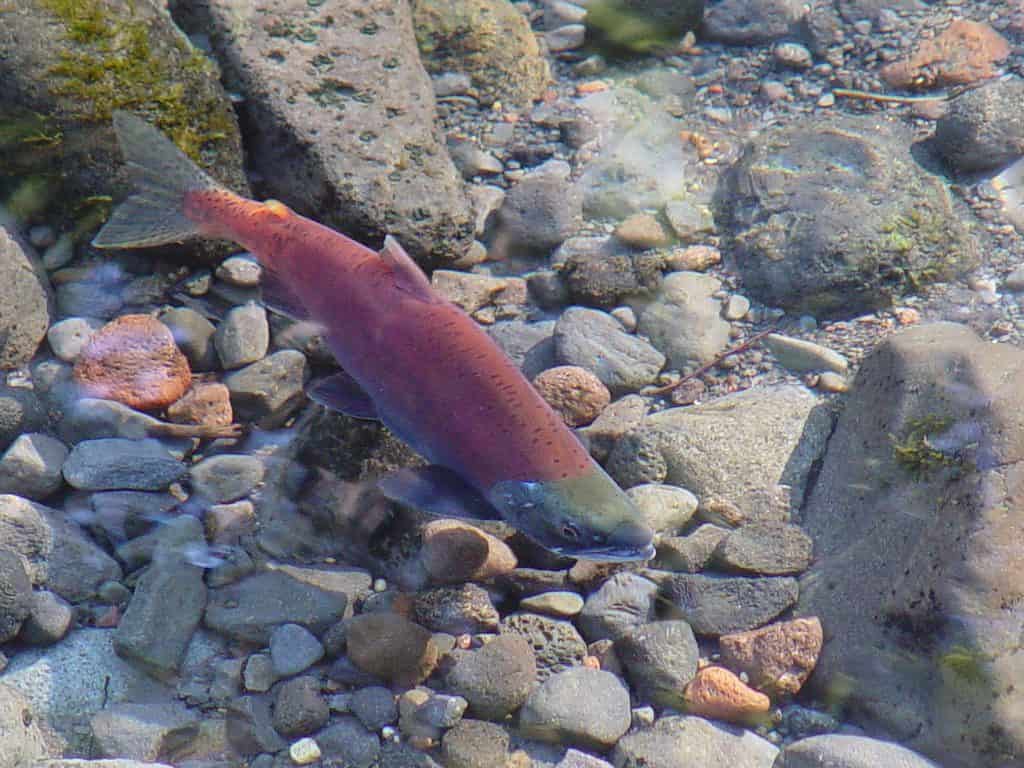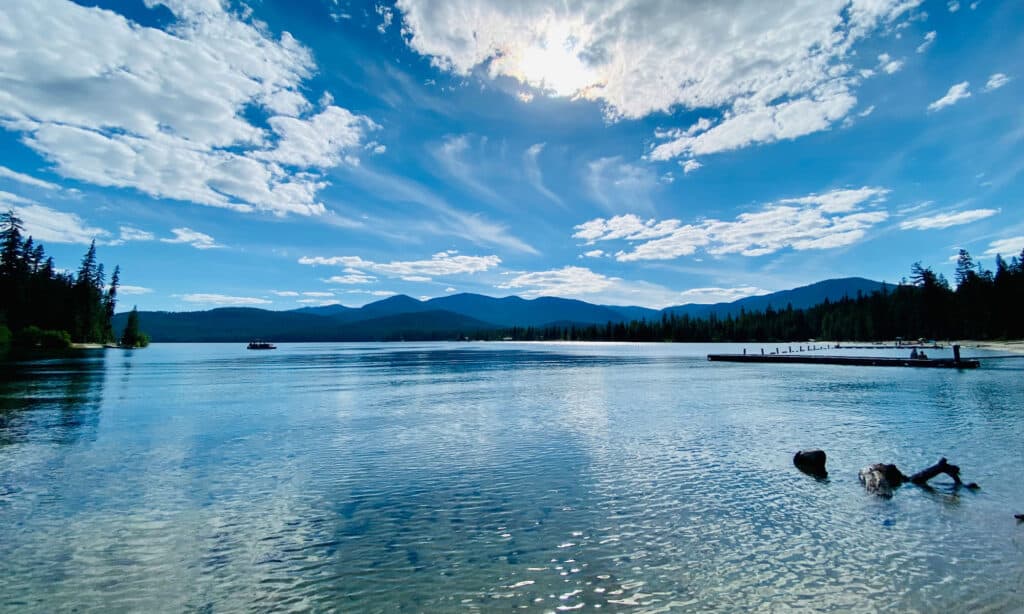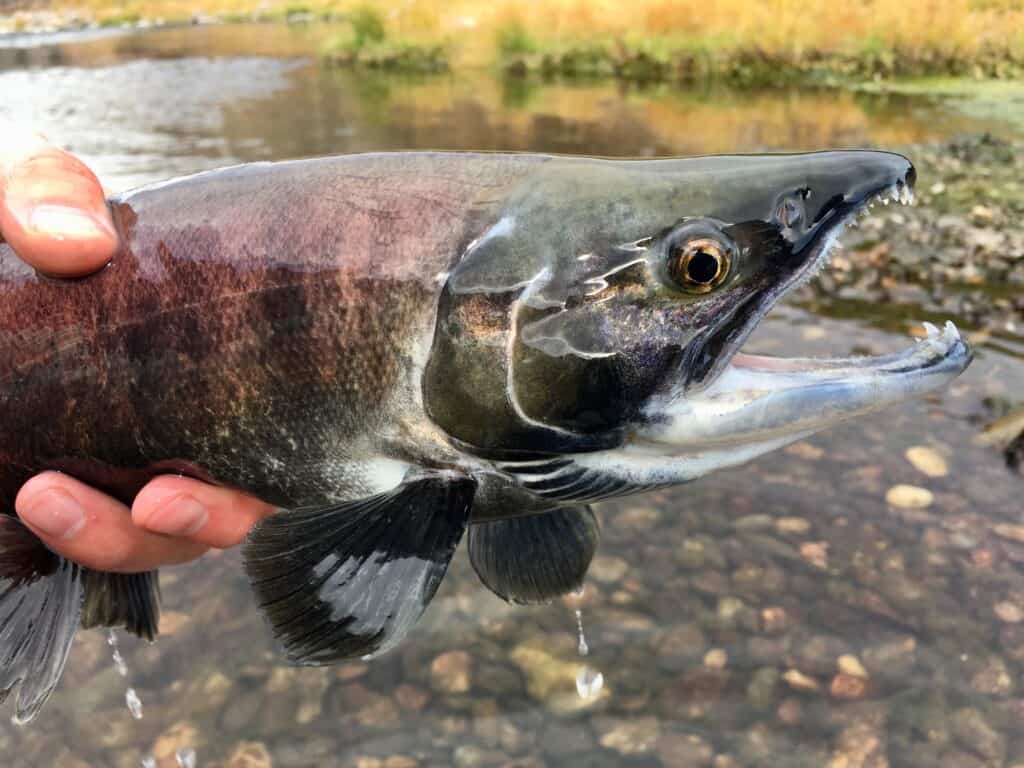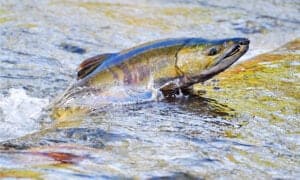There are several different types of salmon that are fished for around the United States. However, there is no species quite like the Kokanee salmon, also known as Oncorhynchus nerka. The Kokanee salmon is a very popular type of fish pined after by anglers around the country. However, they are particularly popular in the state of Idaho.
So, what was the largest Kokanee salmon ever caught in Idaho? We’ll break down the Idaho records for Kokanee salmon catches. We’ll also break down everything else you need to know about this incredible fish!
What are Kokanee Salmon?
Kokanee salmon are a freshwater salmon species that is mostly found in North America. They are sometimes referred to as silver trout. Kokanee salmon are a particular species of sockeye salmon that has evolved to live in freshwater habitats rather than the ocean.
The Biology of Kokanee Salmon
Kokanee salmon are generally smaller than their ocean-dwelling cousins. They often have a blue-green back, little black patches down their flanks, and a dazzling silver tint overall. Males get a vivid red pigmentation on their bellies during spawning season, and both sexes have a notable hooked mouth.
The life cycle of Kokanee salmon is well-known for being quite unique. They are born in freshwater streams and rivers. This is where they spend their first few years of life, just like other salmon species. As they get older, they move to bigger freshwater areas, like lakes. This is where they live out the rest of their lives. The Kokanee salmon do not migrate to the ocean as other salmon species do. Instead, they live their entire lives in freshwater.
Native Range of Kokanee Salmon
Alaska all the way down to California in North America where Kokanee salmon can be found. They are a popular sport fish in the Pacific Northwest, where they are most often encountered. These fish can also be found in portions of the western United States and Canada. Such regions include Montana, Colorado, and (of course) Idaho!
Kokanee salmon often inhabit vast, deep lakes with chilly, oxygen-rich water in the wild. Since the water is cooler and the sunlight is less intense, they can often be found in a lake’s deeper regions. In the fall, they spawn in the rivers and streams that flow into these lakes.
Why Kokanee Salmon Are Unique
Kokanee salmon are special in a number of ways. To begin with, they are the only salmon species whose life span is entirely spent in freshwater. Because of this adaption, they can flourish in freshwater habitats that are unfavorable for other salmon species.
Another characteristic of Kokanee salmon is their unique life cycle. They do not migrate to the ocean, in contrast to other salmon species. Instead, they live their entire lives in freshwater. Their size, coloration, and behavior have all changed as a result of this evolution, along with several other unusual adaptations.
Kokanee salmon are also special because they are loved by fishermen for their tasty meat and challenging behavior. They can be quite difficult to catch and are renowned for their fighting prowess. To catch Kokanee salmon, anglers usually employ specialized equipment and methods, such as downriggers, flashers, and tiny lures.
When it comes down to it, Kokanee salmon are a distinctive and intriguing type of freshwater fish. They are a significant and popular fish in North America. This is because of their unique life cycle, adaptability, and appeal to anglers. However, despite being widely consumed, Kokanee salmon populations are in danger due to overfishing, pollution, and habitat loss. To save these stunning fish and assure their existence for future generations, conservation initiatives are being put into place throughout North America.

Kokanee salmon (pictured) are known for their vibrant coloring (for males) as well as their delicious meat.
Typical Size of Kokanee Salmon
The average weight of a Kokanee salmon is between one and two pounds. This makes them a very tiny species of salmon. Some specimens can grow quite a bit larger, as we’ll see in the catch records later on in this guide.
The size of the lake or body of water where Kokanee salmon are found is one aspect that might affect their size. Kokanee salmon can grow to be larger in large habitats than they would in smaller bodies of water. This is because they have greater room and access to nutrients in larger bodies of water. In that same way, salmon specimens that have access to nutrient-rich foods like zooplankton and insects may also grow larger than others who have a less diversified diet.
Kokanee salmon go through physical changes throughout the spawning season that may affect their size and appearance as well. In addition to having a characteristic hooked mouth, male Kokanee salmon also have brilliant red bellies and green backs. These attributes only develop during the spawning season. These changes don’t affect their size. However, as females produce and carry their eggs, they grow a round, swollen belly and are thus larger.
Kokanee salmon are smaller than many other salmon species, but fishermen admire them for their battling prowess and mouthwatering meat. They are a vital component of many freshwater ecosystems. Kokanee salmon are an essential link in the food chain. They feed eagles, otters, and other fish species as well as other predators.
The Largest Kokanee Salmon Ever Caught in Idaho
The largest Kokanee salmon ever caught in the state of Idaho was a whopping 6.59 pounds. That’s quite a lot more weight than the average one to two pounds of weight that Kokanee salmon tend to carry! The record-breaking specimen was about 24.5 inches long and had a girth of 14.5 inches. This specimen was caught in 1975 by angler Jerry Verge in Priest Lake, which is located in the northernmost area of the Idaho Panhandle.

The largest Kokanee salmon ever caught in Idaho was captured in Lake Priest (pictured).
©iStock.com/Jennifer Davis
The Largest Kokanee Salmon Ever Caught in the World
Anglers from all around the world have taken the time to put their knowledge of the rod and line to the test as they search for the largest Kokanee salmon. But when it comes to record-breaking Kokanee salmon, Ron A. Campbell has held the world record for over a decade. For catching the largest officially recognized Kokanee salmon, Oregon native angler Ron A. Campbell currently holds the International Game Fish Association’s All Tackle World Record.
On June 13th, 2010, at the age of 61, Campbell caught a Kokanee salmon at Wallowa Lake that weighed nine pounds and 10 ounces. The fish measured 17.75 inches in circumference and 27.75 inches long. In 1988, Canadian angler Norm Kuhn set the previous world record. He did so by reeling in a nine-pound, six-ounce Kokanee salmon in British Columbia’s Lake Okanagan. The record remained for 22 years before Campbell broke it and returned the world record title to the United States.
Ron Campbell’s tale illustrates the kind of commitment and effort it often takes for an angler to locate and land a record-breaking kokanee. Wallowa Lake, a five-mile-long lake with an average depth of 300 feet, is situated at a height of almost 4,300 feet among wooded hills and mountain peaks. In his off time, Campbell frequently ventured out on his boat in the hopes of seeing a large Kokanee salmon. His dedication, consistency, and patience paid off.
How the Largest Kokanee Salmon in the World was Caught
Campbell carefully selected his hunting equipment because Kokanee salmon are aggressive when they are caught and are seldom drawn to standard large bait. On that particular Sunday, he utilized a Shasta Tackle Pee Wee Hoochie lure, an Ambassadeur 4500C fishing reel, a 10-pound P-Line, and a Lamiglas Cascade Pro XT rod.
Following his IGFA award, Campbell also received recognition from a number of fishing magazine publishers and tackle manufacturers. Campbell now has lifetime free access to order any fishing tackle from Shasta Tackle Company. As you can see, there are many incentives to catch fish that shatter records!
The History of Fishing for Kokanee Salmon
Fishing for Kokanee salmon has been popular in the United States since the early 1900s. Kokanee salmon fishing is said to have originated in the Pacific Northwest, where the species was originally introduced in the late 1800s. However, the precise origins of Kokanee salmon fishing are unknown.
When Kokanee salmon fishing first began, it was essentially a subsistence endeavor, with Native American tribes catching the fish to feed their villages. However, as recreational fishing gained popularity in the early 1900s, both locals and visitors began to enjoy going Kokanee salmon fishing.
Trolling is a fishing technique where a lure or bait is pulled behind a boat at a slow speed. The method was often used to catch Kokanee salmon and is still somewhat popular today. Anglers use specialized equipment to manage the depth and pace of their lure and to draw fish to their line, such as downriggers and flashers. Kokanee salmon are a favorite target for skilled fishermen because of their reputation for being elusive and potential difficulty in capture.
Kokanee Salmon Conservation
As fishing for Kokanee salmon gained popularity, worries about overfishing and declining populations started to surface. Several states, including Oregon and Washington, enacted laws to restrict the quantity of Kokanee salmon that could be caught and to safeguard spawning populations in the middle of the 20th century.
Unfortunately, habitat loss, pollution, and other factors have led to a continued decline in Kokanee salmon populations in some regions. In some circumstances, overfishing could also be an issue. Although Kokanee salmon are not currently considered to be in danger of extinction, conservation efforts are still necessary to safeguard their populations and guarantee their survival.
The Lake Sammamish Kokanee Conservation Project, which was started in 2007 to safeguard and restore Kokanee salmon populations in Lake Sammamish, Washington, is one example of a fruitful Kokanee salmon conservation initiative. The project has led to considerable increases in Kokanee salmon populations in the lake and consists of a variety of conservation measures, including habitat restoration, predator control, and public education.
To put it simply, the American Kokanee salmon fishing industry has a long history that dates back to the early 1900s. Although fishing has long been a fun American pastime, worries about overfishing and declining populations have in some places led to more regulations and conservation efforts. Even though kokanee salmon aren’t on the endangered species list right now, ongoing conservation efforts are still necessary to safeguard their populations and guarantee their survival for future generations.

Conservation efforts ensure that Kokanee salmon (pictured) can boost their populations in the face of habitat loss and overfishing.
©Ryan Cuddy/Shutterstock.com
The History of Fishing for Kokanee Salmon in Idaho
The state of Idaho’s topography and natural resources play a significant role in the history of Kokanee salmon fishing in the state. These fish have been a favorite catch for fishermen in Idaho for more than a century. The Gem State is home to several lakes and rivers that are perfect habitats for Kokanee salmon.
In the early 1900s, the first Kokanee salmon were imported to Idaho. By the 1920s, recreational fishermen were often going for the species. Worms, flies, and other baits were used as early fishing baits, along with hand lines and cane poles.
New methods and tools were created to aid fishermen in catching more fish as Kokanee salmon fishing gained popularity in Idaho. In many locations, trolling became the method of choice for catching Kokanee salmon. Anglers can now target Kokanee salmon at certain depths and velocities with the aid of downriggers, flashers, and other specialist equipment.
Increased controls on Kokanee salmon fishing in Idaho came about in the middle of the 20th century as a result of worries about overfishing and diminishing populations. To help safeguard spawning populations, catch limitations have been instituted in some areas of Idaho. Just as well, several lakes and rivers in Idaho have seasonal fishing closures to allow the Kokanee salmon’s populations to increase.
With hundreds of fishermen visiting the lakes and rivers of the state each year in quest of these coveted fish, Kokanee salmon fishing is still a popular hobby in Idaho today. Kokanee salmon habitats and populations are being protected and restored in Idaho and elsewhere, despite ongoing worries about diminishing numbers and exploitation in certain locations.
Where is Idaho Located on a Map?
Idaho, situated in the northwestern region of the United States, is renowned for its mountainous terrains and extensive expanses of protected wilderness, offering ample opportunities for outdoor recreation.
The state capital, Boise, is nestled in the foothills of the Rocky Mountains and is intersected by the Boise River, renowned for its rafting and fishing activities. In downtown Boise, the scenic Julia Davis Park along the riverfront provides a green oasis with a rose garden, museums, and a zoo.
Here is Idaho on a map:
Tips for Catching Kokanee Salmon in Idaho
There are a few best practices out there to improve your chances of success if you’re trying to capture Kokanee salmon in Idaho. To start, plan your trip ahead of time. In Idaho, the spawning season lasts from July through October. This is the optimum time to capture Kokanee salmon.
Use the correct equipment. Light tackle, such as a six to eight-pound test line and a tiny spoon or spinner, are often used to catch Kokanee salmon in Idaho. For fishing in deeper seas, downriggers or lead-core lines can also be successful.
Look for the correct areas to fish for Kokanee in Idaho. During the day, Kokanee salmon prefer to gather in deeper waters, and in the early and late afternoon, they tend to move closer to the surface. Look for places with a steep drop-off or an underwater structure since schools of Kokanee may congregate there.
Focus your efforts on regions with water temperatures between 45 and 55 degrees F. This is ideal because Kokanee salmon prefer lower water temperatures. Be persistent and patient since Kokanee salmon are notoriously picky eaters. If you’re not getting any bites, experiment with different bait or trolling speeds.
You can improve your chances of catching Kokanee salmon and have a productive fishing trip by paying attention to these suggestions and conducting your research on the finest fishing locations in Idaho. Good luck!
The photo featured at the top of this post is © topseller/Shutterstock.com
Thank you for reading! Have some feedback for us? Contact the AZ Animals editorial team.






